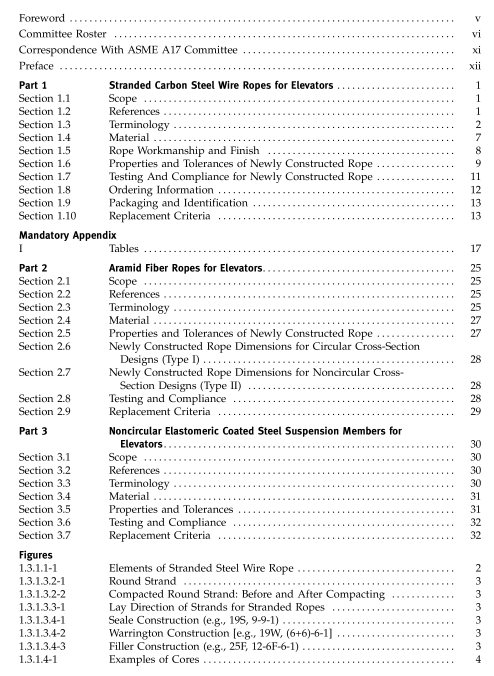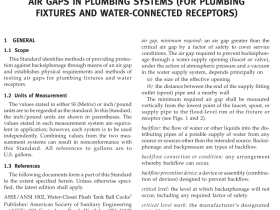ASME A17.6 pdf download

ASME A17.6 pdf download Standard for Elevator Suspension, Compensation, and Governor Systems
1.3.4 Mechanical Properties1.3.4.1 Wire
1.3.4.1.1 Wire Tensile Strength. Ratio between themaximum force obtained in a tensile test and the nomi-nal cross sectional area of the test piece.
Requirements for wire tensile strength are determinedby the tensile strength grade or wire level as specifiedin this Standard for outer wire, by wire level as specifiedby ASTM A 1007 for inner and core wires,or by thetensile strength grade as specified in ISO 2232 for allcomponent wires.
(a) Wire Level. A level of requirement for tensilestrength in pounds per square inch (e.g.,Level 3, seeASTM A 1007).
(b) Tensile Strength Grade. A level of requirement fortensile strength. It is designated by a value accordingto the lower limit of tensile strength and is used whenspecifying wire.
1.3.4.1.2 Torsions.A measure of wire ductilitynormally expressed as the number of 360-deg revolu-tions that a wire can withstand before breakage occurs,using the prescribed test method in ASTM A 1007 orIso 2232.Torsion requirements are based on the wirediameter and wire level or tensile strength grade,asfound in the appropriate wire standard.
1.3.4.2 Rope
1.3.4.2.1 Minimum Breaking Force (MBF). A speci-fied value that the actual (measured) breaking force mustmeet or exceed in a prescribed tensile test.
1.3.4.2.2 Actual (Measured) Breaking Force.Thebreaking force obtained using the prescribed tensile testmethod in ASTM A 931 or ISo 3io8.
1.3.4.2.3 Calculated Breaking Force.The value ofbreaking force obtained from the sum of the measuredbreaking forces of the load-bearing wires in the rope,before rope making, multiplied by the measured spin-ning efficiency.
1.3.4.2.4 Measured Spinning Efficiency.The ratiobetween the measured breaking force of the rope andthe sum of the measured breaking forces of the wires,before rope making.
1.3.4.2.5 Residual Strength.The actual breakingstrength of a suspension member at any time during itsoperational life cycle.
NOTE: The residual strength will be reduced as the suspensionmember is used and is subjected to wear.
1.3.4.3 Rope Stretch (Extension)
1.3.4.3.1 constructional Stretch (Extension). Theamount of extension that is attributed to the initial bed-ding down of wires within the strands and the strandswithin the rope due to loading. Initial extension cannotbe determined by calculation.
1.3.4.3.2 Elastic Stretch (Extension).The amountof recoverable extension that follows Hooke’s Lawwithin certain limits due to application of a load.
1.3.4.3.3 Permanent Stretch (Extension). Nonelas-tic extension.
1.3.5 Rope Manufacture
1.3.5.1 Preformation
1.3.5.1.1 Preformed Rope.Rope in which thewires and strands in the rope will not, after removal ofany seizing (serving), spring out of the rope formation.
1.3.5.1.2 Nonpreformed Rope.Rope in which thewires and strands in the rope will , after removal of anyseizing (serving). spring out of the rope formation.1.3.5.2 Prestretching.The name given to a processthat results in the removal of a limited amount of con-structional stretch.
1.3.5.3 Production Length. The length of rope man-ufactured in one continuous operation from one loadingof the closing machine comprising strands, each ofwhich has been produced in one continuous operationon the stranding machine. A production length maycomprise one or more reels of rope.
1.3.6 Values
1.3.6.1 Nominal Value.The conventional value bywhich a physical characteristic is designated.
1.3.6.2 Actual (Measured) value.Value derivedfrom direct measurement in a prescribed manner.
1.3.6.3 Minimum Value. Specified value that anactual value must meet or exceed.
1.3.6.4 Maximum Value. Specified value that anactual value must not exceed.
1.3.7 Rope Degradation
1.3.7.1 Normal Wear. Ropes showing wear equallyon all strands around the circumference of the rope.
1.3.7.2 Unfavorable Wear.Ropes showing unevenwear and/or rouging due to poor installation,worn sheaves, unequally tensioned ropes, or severe environ-mental conditions.
1.3.7.3 Crown Wire Breaks. Fatigue failure of theouter wire following a diameter reduction due to wear.
1.3.7.3.1 Equally Distributed Breaks.Randomlydistributed wire breaks throughout the lay of the ropewithout any pattern.
1.3.7.3.2 Unequally Distributed Breaks.Wirebreaks predominating in one or two strands within thelay of the rope.
1.3.7.3.3 Side-by-Side Breaks.Four wire breaksin one strand within the lay of a rope that resembles astaircase.
1.3.7.4 Valley Breaks. Wire breaks that are visibleand occur outside of the crown wear area with the crownwire intact.
SECTION 1.4MATERIAL
1.4.1 Rope Wire
The wires used in rope making shall comply with theappropriate parts of this Standard,ASTM A 1007 forrope wire, ISO 2232, or equivalent. For those wires cov-ered by the tables, the manufacturer, subject to the limitsin Table 1.4.1-1,shall decide the tensile grade so thatthe minimum breaking force of the rope is achieved.
1.4.1.1Outer wires shall be made to the tensileranges specified in Table 1.4.1.1-1 and torsion require-ments specified in Table 1.4.1.1-2.
1.4.1.2Wire tensile limitations in Table 1.4.1-1 donot apply to center, filler, and core wires.









